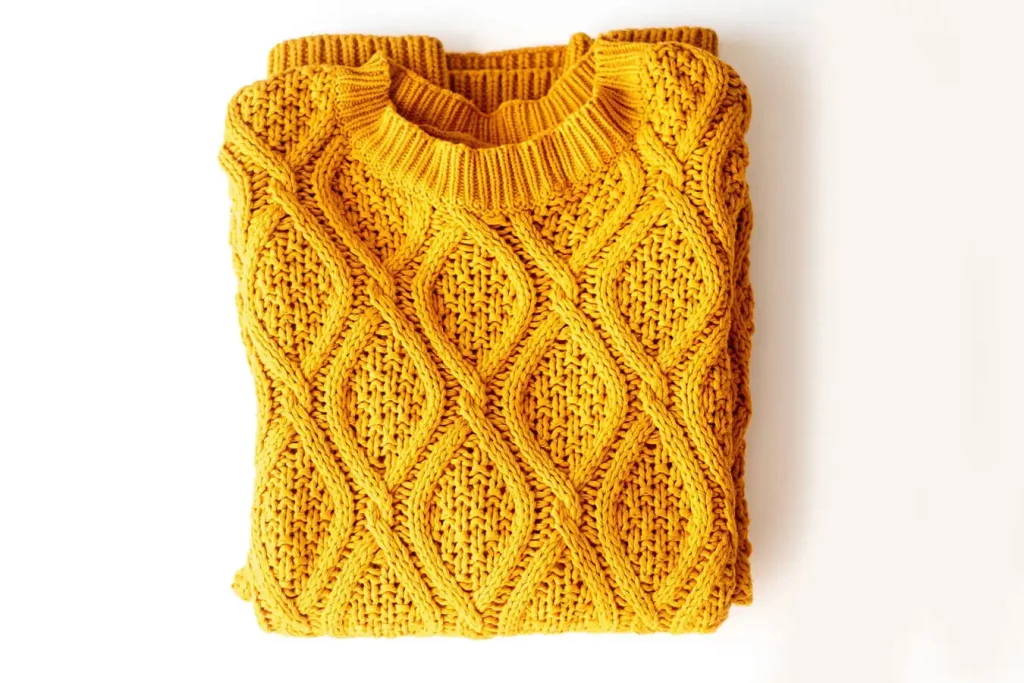Ever paused and thought, “How much does a sweater weigh?” Well, you’re not alone.
It might seem like a quirky question, but for fashion buffs and travel planners, it’s pure gold.
Understanding the weight can seriously influence your packing or shopping decisions.
Let’s unravel this cozy mystery together.
Defining Sweater Weight
What Does Sweater Weight Refer to?
Sweater weight typically refers to the heaviness of a sweater, measured in grams or ounces. It’s often a reflection of the thickness and density of the yarn used, as well as the knitting technique. While it’s not usually printed on the tag, sweater weight can often be inferred from the garment’s description and the listed materials.

Differentiating Between Lightweight and Heavyweight Sweaters
Lightweight sweaters, as their name suggests, are lighter in weight and often made with thin yarns. They are ideal for cool summer evenings or transitioning into fall. On the other hand, heavyweight sweaters are thicker and heavier, designed to provide extra warmth during the chilly winter months. They are often knitted from bulky yarns and possess a denser structure.
Factors Influencing Sweater Weight
Material Used
The weight of a sweater can vary significantly depending on the material used. For instance, woolen sweaters, especially those made from merino or Shetland wool, tend to be heavier due to the naturally dense structure of the wool fibers. Cashmere sweaters, while incredibly warm, are typically lighter in weight because of cashmere’s unique insulating yet lightweight properties.
Cotton sweaters, on the other hand, offer a medium-weight option, ideal for milder temperatures. Sweaters made from synthetic materials like polyester can range widely in weight, depending on the thickness of the yarn and the tightness of the weave.
Sweater Size
As you might expect, the size of the sweater plays a significant role in determining its weight. Larger sweaters require more material to make and, therefore, typically weigh more than smaller ones. For instance, an oversized chunky knit will undoubtedly tip the scales more than a fitted lightweight cardigan.
Sweater Design
Design elements can also impact a sweater’s weight. A basic pullover with a simple stitch pattern will generally be lighter than an elaborate Aran or Fair Isle sweater laden with complex cable or colorwork patterns. Moreover, additional embellishments like buttons, zippers, or appliqués will add extra weight to the garment.
Learn more: What Material are Sleeping Bags Made Of
Average Weights of Different Types of Sweaters
Wool Sweaters
A typical wool sweater, say a medium-sized men’s pullover, can weigh around 450-600 grams (roughly 1-1.3 pounds). Factors influencing the weight include the type of wool used (Merino wool tends to be lighter than Shetland wool), the thickness of the yarn, and the complexity of the design.
Cashmere Sweaters
Cashmere sweaters are renowned for their warmth-to-weight ratio. A medium-sized cashmere sweater might weigh between 250-400 grams (around 0.55-0.88 pounds), depending on the ply of the cashmere and the tightness of the weave.
Cotton Sweaters
Cotton sweaters offer a medium-weight option. A typical cotton sweater might weigh around 300-500 grams (roughly 0.66-1.1 pounds), with variations depending on the type of cotton used and the knitting style.
Synthetic Sweaters
The weight of synthetic material sweaters can vary widely based on the specific material and the construction of the sweater. However, a typical synthetic sweater might weigh between 300-600 grams (roughly 0.66-1.3 pounds).
The table below about the average weights of different types of sweaters discussed in this article:
| Sweater Type | Average Weight (grams) | Weight (lbs) | Average Weight (oz) |
| Wool Sweater | 450-600 | 0.99-1.32 | 15.87-21.16 |
| Cashmere | 250-400 | 0.55-0.88 | 8.82-14.11 |
| Cotton | 300-500 | 0.66-1.1 | 10.58-17.64 |
| Synthetic | 300-600 | 0.66-1.32 | 10.58-21.16 |
In short, the weight of a sweater can vary based on its material and size, but on average, it typically weighs between 0.66 lbs to 1.32 lbs (300g to 600g).
Read more: How Much Does a Hoodie Weigh
Practical Implications of Sweater Weight
Impact on Comfort
The weight of a sweater directly influences how it feels when worn. Lightweight sweaters are ideal for layering and transitional weather, offering comfort without bulk. On the other hand, heavyweight sweaters can provide a cozy, secure feeling, perfect for chilly winter days.
Shipping Considerations
Sweater weight becomes a crucial factor when it comes to shipping. Heavier sweaters may incur higher shipping fees due to their weight, particularly when shipping internationally. As an online shopper, being aware of a sweater’s weight can help you anticipate potential shipping costs.
Environmental Impact
The weight of a sweater also plays a role in its environmental footprint. Heavier sweaters require more material to produce and more energy to transport, which could potentially increase their environmental impact. On the flip side, more durable materials, though heavier, might lead to longer garment lifespans, reducing the frequency of replacement and associated environmental effects.
Therefore, when choosing a sweater, it’s not just about style and comfort—understanding the weight of your sweater can also have wider implications for your wallet and the world around us.
Know more: How Much Does a Sleeping Bag Weigh
FAQs About How Much Does a Sweater Weigh
How much does a cardigan weigh?
How much does a women’s cardigan weigh?
How heavy is a sweater in KG?
How much does a jumper usually weigh?
How much does a standard sweater weigh?
What is the average weight of a hoodie?
How many ounces does a hoodie weigh?
Summary
In this journey, we’ve delved into understanding the weight of a sweater, and it’s safe to say it’s more than just a trivial detail. The weight of your sweater is a product of the type of material used, the size of the sweater, and its design. These factors not only influence the physical heft of the garment but also impact how the sweater feels when worn and how warm it keeps you.
The material, be it wool, cashmere, cotton, or synthetic, plays a critical role in defining the weight. With wool sweaters generally being heavier and cashmere sweaters providing warmth with less weight, the choice of material becomes an essential aspect to consider.
By being aware of the average weights of different types of sweaters, you can make more informed decisions, whether you’re packing for a trip, shipping a gift to a loved one, or making more sustainable shopping choices. Enjoy!
To know more: What Material Provides Warmth Even When Wet


